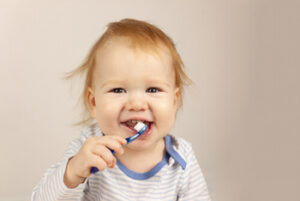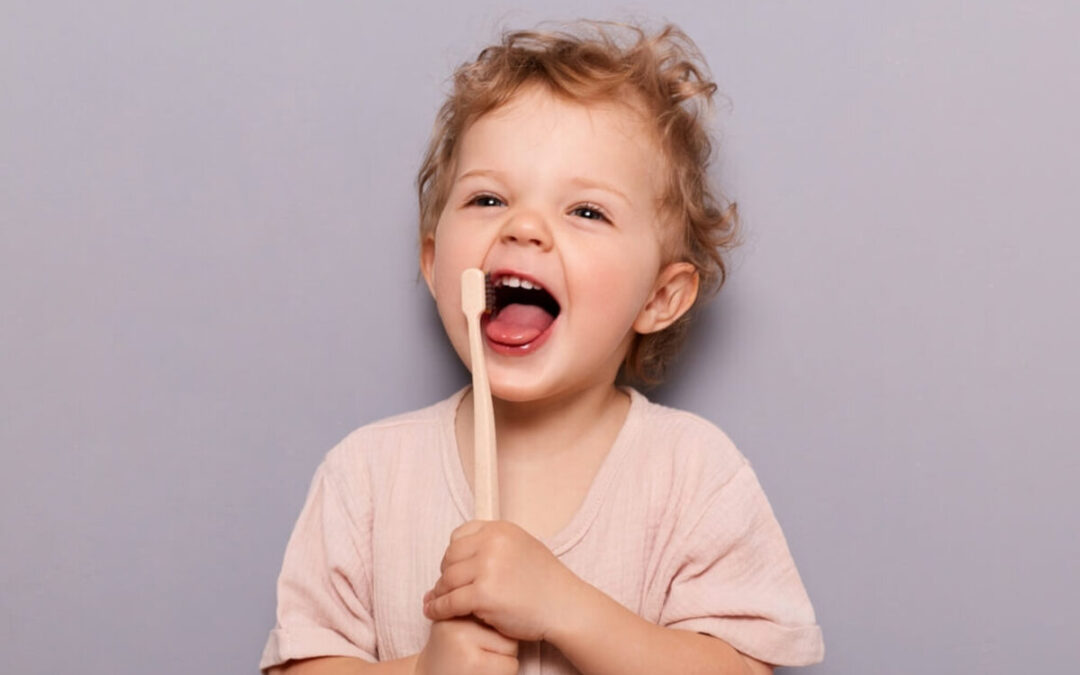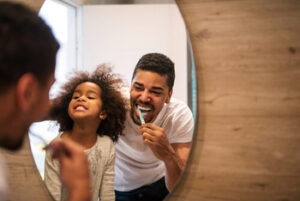Understanding “How to brush your teeth: for kids” is crucial in establishing a lifetime of good oral health. Brushing teeth is more than just a daily routine; it’s a preventive measure against tooth decay, gum disease, and other dental caries. A child’s teeth are particularly susceptible to decay because of the sugars often found in children’s diets. Believe it or not, even baby teeth need proper care. The surfaces of the teeth, especially the chewing surfaces, can harbour bacteria and food particles. Without proper cleaning, these can lead to cavities.
Brushing children’s teeth should begin as soon as the first tooth appears in a child’s mouth. Using a toothbrush with soft bristles and fluoride toothpaste, even just a pea-sized amount, can make a difference in preventing tooth decay. The Australian Research Centre emphasises that children’s teeth brushing should be done twice a day, once in the morning and before bed, for optimal dental care.
In this guide, we’ll dive deeper into the steps to ensure your child’s teeth are brushed properly, exploring both manual toothbrushes and electric toothbrush options. Whether you’re teaching an older child to brush their teeth or brushing your child’s teeth for them, this step-by-step guide is designed to help.
Why Kids Should Brush Their Teeth
Brushing teeth is not just a chore; it’s a cornerstone for good oral health, especially for children. Here’s why it’s imperative:
Health Benefits
From the moment the first tooth appears in a child’s mouth, their dental care journey begins. The surfaces of the teeth, particularly the chewing surfaces, can accumulate bacteria. Regular tooth brushing using a toothbrush with soft bristles ensures these bacteria are efficiently removed. Brushing your child’s teeth daily using fluoride toothpaste also strengthens the enamel, making teeth more resilient against decay.
Prevention of Cavities and Gum Disease
Children’s diets often consist of sugars, which can lead to tooth decay if left unchecked. Brushing children’s teeth, especially after consuming sweet foods or drinks, helps prevent tooth decay. Furthermore, paying attention to the gum line when brushing ensures the prevention of gum disease. Remember, even baby teeth are vulnerable to cavities, so starting early is essential.
Importance for Overall Well-being
A child’s teeth play a crucial role in their overall health. Untreated dental issues can lead to pain infections and even impact a child’s nutrition and speech. By emphasising good oral hygiene from a young age, you’re not only promoting dental health but also ensuring their overall well-being.
In essence, understanding “How to brush your teeth: for kids” sets the foundation for a lifetime of healthy habits. This daily routine, ideally done twice a day in the morning and before bed, can save countless trips to the dentist and ensure a bright, healthy smile for years to come.
Choosing the Right Tools
Ensuring your child practises good oral hygiene starts with choosing the right tools. When learning how to brush your teeth for kids, selecting the best toothbrush and toothpaste plays a significant role. Here’s a guide to help you pick the right ones:
Picking a Child-Friendly Toothbrush:

– Bristle Type: Soft bristles are ideal for children as they clean teeth properly without causing harm to the gums or tooth surfaces. Brushing your child’s teeth shouldn’t be a painful process.
– Designs: Fun designs, characters, or even electric toothbrush options can make brushing appealing. Letting your child choose their brush can make them more eager to use it daily.
Selection of Kids Toothpaste:
– Fluoride vs. Fluoride-free: Fluoride toothpaste helps prevent tooth decay and strengthen the enamel. However, for very young children who might swallow toothpaste, fluoride-free options can be considered. Consult your dentist to understand the right choice for your child.
– Tasty Flavours: Kids toothpaste often comes in flavours appealing to children, making the brushing routine less of a chore. Whether it’s bubblegum, berry, or any other flavour, find one your child likes. Just ensure they spit it out post-brushing!
When children start brushing their teeth, ensure they brush gently, focusing on all the surfaces of the teeth and using only a pea-sized amount of toothpaste. This routine ideally maintained twice a day – in the morning and before bed, will set them on the path of maintaining great oral health throughout their lives.
The Step-by-Step Process
Good oral hygiene is vital from an early age, and this is what we’re highlighting in this guide, “How to brush your teeth: for Kids”, which involves more than just moving the brush around. It’s about technique, the right amount of toothpaste, and even the way we care for our tools. Here’s a comprehensive step-by-step guide:
Wetting the Toothbrush: Start by letting your child wet their toothbrush. Whether it’s a manual toothbrush with a small head or an electric toothbrush, it’s essential to wet the toothbrush bristles. Wetting them ensures the toothpaste spreads more easily and helps soften the bristles for a gentler clean.
Applying the Right Amount of Toothpaste:
You don’t need much! For toddlers, just a smear of fluoride toothpaste is sufficient. As your child grows and can spit properly, typically by age three or four, you can increase the amount to a pea-sized dollop.
Correct Brushing Technique:
– Circular Motions: Teach your child to use small circles when brushing their teeth. This motion cleans the surfaces of the teeth more effectively and is gentler on the gums than back-and-forth strokes.
– Brushing Every Tooth Surface: Emphasise the importance of brushing all tooth surfaces. The outside surfaces, the inside surfaces, and especially the chewing surfaces need attention. They should also remember to brush gently along the gum line, where plaque often accumulates.
– Gentle Strokes: Using a toothbrush gently ensures that the soft bristles clean effectively without causing any harm to the gums or teeth.
Brushing the Tongue and Roof of the Mouth
Many children forget these areas, but bacteria also reside here. A gentle brush across the tongue, from back to front, and the roof of the mouth can significantly reduce bad breath and improve overall oral health.
 Rinsing Mouth and Toothbrush
Rinsing Mouth and Toothbrush
Post-brushing, children should rinse their mouths with water to get rid of any leftover toothpaste and dislodged particles. They should spit out the water and ensure not to swallow any residual toothpaste. The toothbrush, too, should be rinsed thoroughly under tap water to remove toothpaste and debris. This cleaning process ensures the brush remains hygienic for the next use.
Steps for Flossing (if age-appropriate)
Introducing Flossing can be a good practice as soon as two teeth touch each other, but always under adult supervision.
– Start with about 18 inches of floss, winding most of it around the middle finger of one hand and the rest around the middle finger of the other hand.
– Hold the floss tightly between the thumbs and forefingers and gently insert it between the teeth.
– Curve the floss into a “C” shape against the side of the tooth and slide it under the gum line and along the side of each tooth.
– Use fresh sections of the floss as you move from tooth to tooth.
Remember, brushing should ideally be a routine activity performed twice a day, once in the morning and once before bed. Make it a daily routine, turning it into a fun activity rather than a chore. Play a favourite song, or invest in a themed toothbrush and toothpaste. These small steps can make a significant impact on a child’s perception of dental care.
Lastly, always encourage regular check-ups with the dentist. They can provide additional advice tailored to your child’s teeth and ensure that they are on the right track for long-term oral health.
Making Brushing Fun for Kids
For many parents, brushing children’s teeth can sometimes feel like an uphill battle. The good news is that there are numerous creative strategies to make tooth brushing a delightful experience. After all, good oral health habits from a young age can prevent tooth decay and gum disease.
Using a Timer or a Fun Song
A two-minute song can serve as a fun, musical timer, ensuring kids brush their teeth properly. It’s a great way to integrate this guide, “How to brush your teeth, for kids”, into a daily routine. From pop hits to nursery rhymes, pick a favourite and let it play every morning and night.
Sticker or Reward Charts
Children love rewards! Create a monthly calendar and allow your child to place a sticker every time they brush their teeth. At the end of the month, a full chart could lead to a small reward. This system not only encourages consistent brushing but also tracks a child’s teeth-brushing habits.
Fun Brushing Apps and Games
There are numerous interactive apps available designed to teach kids the importance of dental care in an engaging way. These apps often have animated characters, challenges, and rewards that keep children hooked and make brushing an exciting activity.
Themed Toothbrushes and Toothpaste
From superheroes to princesses, there’s a plethora of themed toothbrushes with soft bristles out there. Pair them with matching fluoride toothpaste, and your child will be eager to start brushing. Whether it’s a manual toothbrush or an electric toothbrush, let your child choose their favourite.
Remember, every child develops at their own pace. While a toddler might be excited about their first toothbrush with a small head, older children might be more inclined towards an electric toothbrush that feels more ‘grown-up.’ The key is to make brushing your teeth an enjoyable activity rather than a chore. And remember, regular check-ups with the dentist and a balanced diet play a crucial role in maintaining those pearly whites.
Common Mistakes and How to Avoid Them

Conclusion
Maintaining good oral hygiene from a young age sets the foundation for lifelong dental health. The steps we’ve explored not only help prevent tooth decay but also instil the importance of regular dental care in our young ones. It’s essential to understand that brushing teeth properly goes beyond just a daily routine; it’s about ensuring our children’s teeth and gums remain healthy and strong.
Every time we assist our kids in brushing or encourage them to do it on their own, we’re equipping them with the tools they need to combat dental caries, gum disease, and other oral health challenges. But, as with any skill, it’s not just about knowing how to do it but about doing it right. The common mistakes we’ve discussed serve as a reminder that even seemingly minor oversights can have significant repercussions over time.
Bright-On Bay Dental is committed to supporting families in their quest for optimal oral health. Our experts are always ready to guide you and your child through the nuances of dental care. If you have concerns, questions, or need advice, don’t hesitate to reach out. Visit us at Bright-On Bay Dental or give us a call at 02 9538 7028. Your child’s bright smile is our top priority.
References:
https://www.nhs.uk/live-well/healthy-teeth-and-gums/taking-care-of-childrens-teeth/
https://medlineplus.gov/ency/patientinstructions/000769.htm
www.healthywa.wa.gov.au/Articles/A_E/Brushing-your-childs-teeth
www.colgate.com.au/oral-health/selecting-dental-products/kids-toothbrushes-what-to-buy-for-your-child


 Rinsing Mouth and Toothbrush
Rinsing Mouth and Toothbrush
Recent Comments